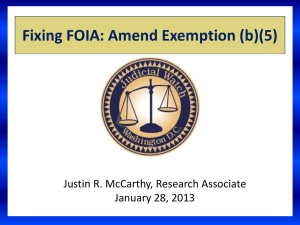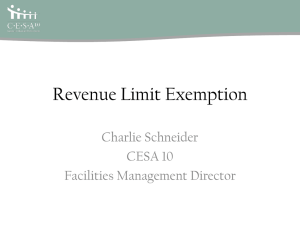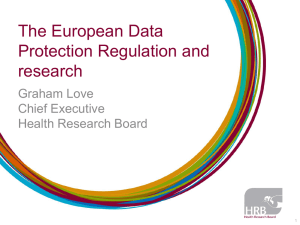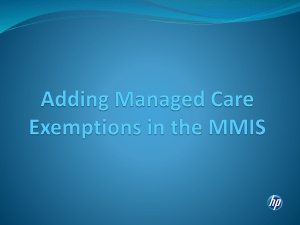Freedom of Information Act - National Security Counselors
advertisement
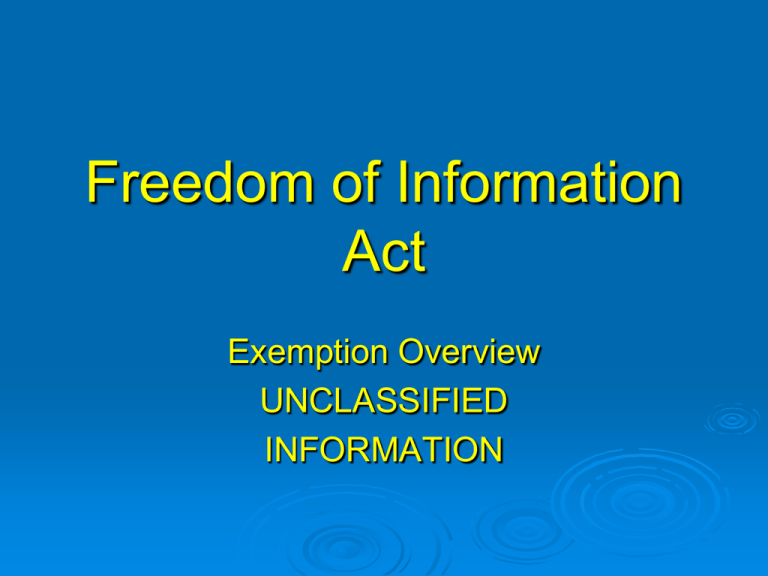
Freedom of Information Act Exemption Overview UNCLASSIFIED INFORMATION FOIA Exemptions The FOIA is found in Title 5 United States Code Section 552 (5 U.S.C. § 552) There are 9 FOIA exemptions This briefing will cover Exemptions 1, 2, 3, 4, 5, 6, and 7 Exemption 1: 5 U.S.C. § 552(b)(1) Applies to information which is currently and properly classified in the interest of national defense or foreign policy, as specifically authorized under the criteria established by Executive Order and implemented by regulation (such as DoD 5200.1-R). Exemption 1 Executive Order 12958, as amended May classify after receipt of FOIA request-§ 1.7(c) (procedures to follow) Compilation/Mosaic approach Properly marked documents Glomar response Exemption 1 New additions to classification categories: “Transnational Terrorism”--§ 1.4(e) & (g); “Infrastructures” --§ 1.4(g); “Weapons of Mass Destruction”--§ 1.4(h) Presumption for classification of “Foreign Government Information”--§ 1.1( c) Freedom of Information Act U.S.C. § 552(b)(2): Protects records that are “related solely to the internal personnel rules and practices of an agency.” 5 Two parts: • High: 1. operating rules; guidelines; manuals for investigators, auditors or examiners 2. examination questions and answers used for training, employment or promotion 3. computer software, if disclosure would allow circumvention and meets agency record test Exemption 2 Predominantly internal Release would cause agency harm (Homeland security information) Public interest in disclosure is irrelevant Courts willing to go further to protect law enforcement material/information Exemption 2 Low 2: Covers trivial information of no public interest Predominantly internal No genuine public interest Does information “shed significant light” on personnel rules and practices (routine matters/performance stds vs. public interest/honor code proceedings)? FOIA Exemptions Exemption 2 (cont’d) Low: trivial information parking facility rules; lunch hour rules; sick leave policy; mail routing stamps; initials Awards, travel expenses, file numbers, data processing notations (Senate intent) (b)(2) High Vulnerability studies Schreibman v. U.S. Department of Commerce Examples: Pentagon AC Ducts Lock mechanism manuals Exemption 2 FOIA disclosure should not “benefit those attempting to violate the law and avoid detection.” Must make determination of reasonably expected harm Used with Exemption (b)(7)(E) to protect law enforcement techniques and manuals Remember that information must be internal to be protected under Exemption 2 EXEMPTION 3 Exemption 3 incorporates other federal nondisclosure statutes into the FOIA See WORD document listing (b)(3) exemptions EXEMPTION 4 Exemption 4 protects trade secrets and commercial or financial information that is privileged or confidential FOIA Process must comply with EO 12600, requiring “submitters notice”, i.e., review of contract by its submitter, for information that would infringe on a commercial advantage of proprietary information Action office with the contract requests contractor review with 1-month suspense Can protect the Government’s proprietary interest Bottom line: the Contractor makes the call Exemption 5 U.S.C. § 552(b)(5): Protects “interagency or intra-agency memorandums or letters which would not be available by law to a party other than an agency in litigation with the agency.” 5 What does “inter- or intra-agency memorandum or letter” mean? Exemption 5 Exemption 5 threshold issues: • Inter-agency (between) or intra-agency (within): Klamath Water Users case (Functional test) • Memorandum or letters Covers anything in your file • “Not available by law” refers to iformation normally privileged in civil discovery Exemption 5 Three main privileges: Deliberative Process Privilege Attorney Work Product Privilege Attorney Client Privilege Deliberative Process Privilege • Designed to facilitate agencies’ decision making process Deliberative Process Privilege Three rationales: 1. Protect candor of the decision makers 2. Protect against premature disclosure of proposed policies 3. Prevent confusion of the public Deliberative Process Privilege How to determine if a document is deliberative: Look at who has decision-making authority (chain of command) Look at direction document flows along decisionmaking chain (employee to supervisor) Is substance of document analysis, evaluations, advice, recommendations? Cannot protect the facts—must segregate facts from deliberative material Deliberative Process Privilege Two parts to this privilege: 1. The information must be predecisional: • “Antecedent to the adoption of an agency policy” • Not final agency decisions or statements of agency policy • Not post-decisional statements that explain decisions • Predecisional documents can lose their protection as such Deliberative Process Privilege 2. The information must be deliberative: • Analysis, evaluations, comments, advice, recommendations • Drafts: If a document is a draft, you can protect it all including the facts, even if the draft is identical to the final version. Stamping a document a “Draft” will not on its own provide protection from disclosure Attorney Work Product Privilege Protects adversarial trial process by insulating attorney’s preparation from scrutiny Protects documents prepared by an attorney or at his or her direction in reasonable anticipation of litigation—can be used to cover work done by law enforcement agents/investigators Attorney Client Privilege Protects confidential communications between an attorney and client regarding a legal matter for which client seeks professional advice. Protects facts divulged by client to attorney AND opinions given by attorney based on those facts Confidential communications within the government Exemptions 6 & 7(C) The Personal Privacy Exemptions: Exemption (b)(6) permits the government to withhold all information about individuals in “personnel and medical files and similar files” when the disclosure of such information “would constitute a clearly unwarranted invasion of personal privacy.” Non-law enforcement personal privacy exemption Personal Privacy Exemptions Exemption (b)(7)(C) permits the government to withhold information compiled for law enforcement purposes the disclosure of which “could reasonably be expected to constitute an unwarranted invasion of personal privacy.” Both Exemption 6 and 7( C) require a balancing of the privacy interest with any public interest in disclosure Personal Privacy Exemptions 4-Step 1. 2. 3. 4. Analysis: Which exemption applies? Is there an identifiable privacy interest? Is there a legitimate public interest? Balance the two interests Personal Privacy Exemptions Examples of Privacy Interests: Age; marital status; home address; medical conditions; performance appraisals; criminal convictions; information about unsuccessful job applicants; information that, although perhaps once public, has become “practically obscure.” “Practically obscure”—rap sheets Personal Privacy Exemptions Examples where there is no Privacy Interest: Deceased individuals generally have no privacy interests; however, courts do recognize “survivor privacy interests” Corporations Federal employees, except for some federal agencies (DoD names policy) Identities of FOIA requesters Personal Privacy Exemptions Public Interest under the FOIA That which sheds light on the operations and activities of the federal government — Reporters Committee case. • Focus on agency’s conduct, not personal conduct of individuals • Information about private citizens will rarely show the operations and activities of the government. • Duty to segregate non-exempt information Exemption 7 Protects information compiled for law enforcement purposes, including criminal, civil, administrative and regulatory proceedings; 6 Subparts allow for the withholding of information compiled for law enforcement purposes on the basis of the potential harm resulting from release Exemption 7 Subparts (A) could interfere with pending or prospective enforcement proceeding; (B) would deprive an individual of the right to a fair trial; (C) could reasonably be expected to constitute an unwarranted invasion of personal privacy; Exemption 7 Subparts (D) could reasonably be expected to disclose identity of confidential source . . . or information provided by source; (E) would reveal techniques or procedures for law enforcement investigations or guidelines if could risk circumvention; (F) could reasonably be expected to endanger life or physical safety of individual
